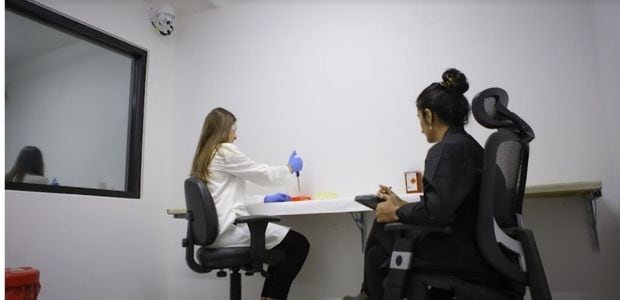
IVD Clinical Trial Study Design Tips for Respiratory and Oncology Devices
Creating One Machine to Perform Multiple Tasks
If you’re in the early stages of planning a clinical trial for an In Vitro Diagnostic (IVD) device you may be researching how best to approach your trial to ensure you get the data needed for your regulatory submission. However, since most CROs focus on pharmaceuticals, much of the guidance you find online tends to focus on this market segment. IVDs, as you are well aware, are not the same as pharmaceuticals. The regulatory pathways are different, the agencies reviewing the data are different, and the protocols are different. Here are some quick tips for planning your trial so that you can achieve your outcomes and endpoints as quickly as possible, and in the most cost-effective manner.

Proven Expertise, From Concept to Market
Don’t Underestimate the Number of Enrolled Patients Needed
IVD manufacturers often scramble to get more data because they underestimate the prevalence of the condition being tested. Here’s how that can affect your regulatory submission. Let’s say you have a new assay that detects influenza A and/or B viruses, and you are collecting data to support a 510(k) submission to the US FDA. For Dual 510(k) and CLIA waiver submissions for an influenza test, you will need at least 120 positives for both influenza A and B.
————————————————————————————
Experience counts: Key members of our IVD CRO team worked on one of the first successful Dual 510(k) and CLIA waiver submissions granted by FDA.
————————————————————————————
So how many subjects do you need to enroll in your study? If there is a 5% positivity rate, you will need at least roughly 2,500 subjects for a dual submission! Furthermore, depending on your claims and use environment, the regulatory agency may want symptomatic negative enrollment and asymptomatic enrollment, pediatric and assisted collection enrollment etc., further adding size and complexity to the study. The number of subjects screened and how long it takes to get them entirely depends on:
- Seasonality
- Prevalence
- Number of clinical trials sites
- Geographical location of sites
- Volume of patients coming through each site

Diversify Your In vitro Diagnostic Trial Site
With flu studies, seasonality is obviously a huge factor in determining how quickly you reach your objectives. If you are beginning your study in the spring, influenza is basically nonexistent in the US from April through September, but then peaks in December through March. As such, you may need to split your sites to collect some data in other countries or geographic regions, such as Australia or Southeast Asia, or your study may take more time than necessary.
Keep in mind that the prevalence of different strains in different geographical markets will affect how many patients are needed to meet the required number of positives. To meet your quotas in a timely manner, we recommend having at minimum of 10 clinical sites. The US FDA wants your testing sites to be geographically distinct and representative of the intended user and environment in which the test is used.
————————————————————————————
Aiming for FDA Dual 510(k) and CLIA Waiver Submission? If you are pursuing a Dual 510(k) and CLIA waiver, remember that the FDA strongly advises sponsors to follow their guidance on how much (if any) training to give to IVD clinical study participants as follows:
“While a premarket notification (510(k)) and CLIA Waiver by
application each include discrete elements not required in the
other, both submissions generally include comparison and
reproducibility studies. For a 510(k), such studies are often
performed by trained operators (i.e., test operators who meet
the qualifications to perform moderate complexity testing;
sometimes referred to as “moderate complexity users”). For a
CLIA Waiver by application, we believe such studies should be
conducted by the intended user (i.e., test operators in waived
settings and with limited or no training or hands-on
experience in conducting laboratory testing; sometimes
referred to as untrained operators or waived users (emphasis
added).”
————————————————————————————
More Touchpoints Increases Study Complexity and Length
Another thing to consider is how many clinicians and doctors are involved in sample collection and processing. While a respiratory IVD device may have relatively simple sample collection and processing, oncology IVDs present a new level of complexity. Let’s use a colonoscopy as an example. Patients often have colonoscopies at outpatient surgical centers which will involve a nurse, anesthesiologist, various technicians, and the gastroenterologist. That’s just for the procedure. Concerning polyps are removed during the procedure and sent to a lab for cancer screening, whereby an oncologist may review the results and report them to the gastroenterologist, primary care physician and patient. Because there are so many people involved, and different locations as well, you need to appropriate plan for this complexity

How Much OUS Data is Acceptable to FDA for IVD Trials?
As we mentioned earlier, the seasonality of outbreaks can greatly impact the duration of your IVD clinical study. Many sponsors wonder how much foreign data (OUS – Outside the US) is acceptable for IVD clinical trials. The unsatisfying answer is “it depends.” The FDA wants to know that your OUS patient population has similar characteristics to the US population and that your studies have been performed by clinical investigators with demonstrable competence. Before designing and planning your trials, we highly recommend that you utilize the FDA IVD pre-submission process. This will allow you to get formal written feedback from the FDA (or have a physical/phone meeting) about your proposed study design or approach, including the proposed use of foreign data.
Optimize Your IVD Quick Reference Guide
Typically, in the months leading up to the start of an IVD clinical trial, the focus is on finalizing product design and crafting the Instructions for Use (IFU). However, at this stage many IVD manufacturers fail to place enough emphasis on the Quick Reference Guide (QRG) that will also accompany the product. The reality is that the QRG will often supplant the IFU as the “go to” means by which people learn how to use your device. Typically, this is because the QRG is quick and easy to follow, visually focused and only shows the essentials needed to safely and accurately use the test. The IFU, by contrast, often includes a prodigious amount of information deemed necessary for regulatory compliance or the reduction of legal liability. Its sheer mass intimidates most people which is why they gravitate toward the QRG
That’s why the FDA wants to see that your IVD can be administered safely and effectively using the QRG only. As you can imagine, a poorly designed QRG can adversely impact your clinical trial (costing you more money). Make sure your illustrations and captions are really good and conduct formative usability studies to work out the use errors with your QRG prior to the clinical trial.
Conduct IVD Usability and Labeling Testing Well Before the Clinical Trial
Under pressure to accelerate time to market, we often see clients lock down design and rush into trials without first doing adequate usability testing on their device. This approach can end up causing you issues during trials, including preventable delays while your team makes design adjustments after getting user feedback. If you are introducing an entirely new design, we recommend conducting a human factors study of your IVD to test the usability of your device well in advance of initiating the clinical study.


